High Peaks Pure Earth has translated a blogpost by Woeser written on September 7, 2011 for the Tibetan service of Radio Free Asia and posted on her blog on September 17, 2011.
In a series of posts making up Woeser’s summer travels to Lhasa, through Amdo and Kham, the post below is the follow up to “Magnificent Dzogchen Monastery“. This post finds Woeser still in Kham and this time the post focuses on local Tibetan objections to yak meat processing plants in the area. These tensions described in the post give context to events that unfolded some months later also in Kardze Prefecture, see this report by Radio Free Asia from December 1, 2011.
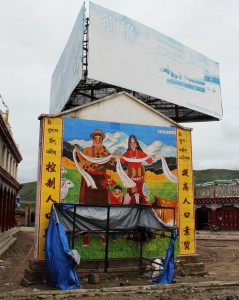
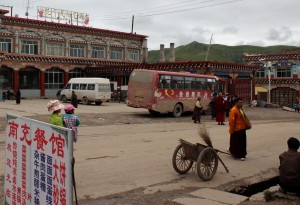
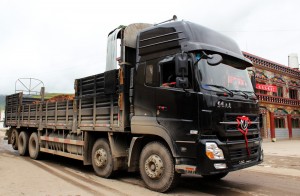
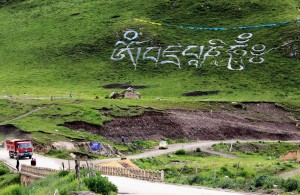
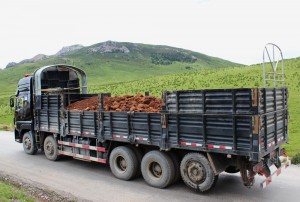
“Mani Gego’s Yak Meat Processing Plant” By Woeser
Mani Gego is a transportation hub. Some people say that Mani Gego resembles the Hong Kong martial arts film “Dragon Inn”, the air full of the heroism of Khampa men. But this is not actually the original atmosphere. What Mani Gego actually means is: the hillside is densely lined with Mani stones engraved with ancient scriptures. This was the scenery in the past but it has vanished today. What happened to all these Mani stones? Were they taken away during the Cultural Revolution or during the earlier Republican Revolution? Were they used by revolutionaries to build barracks or government buildings? And what about the remaining stones, weren’t they stolen by people to build shelter for people and livestock?At the end of July, we hurried from Dzogchen Monastery to Mani Gego and from far away we spotted a huge propaganda poster on family planning towering above the road, showing a Khampa couple dressed in Derge garments smilingly holding up Tibetan khatas; in the forefront there was a little boy holding fresh flowers and a small yak, two lambs, altogether creating an image of a happy life.
Mani Gego has already lost its “Dragon Inn” atmosphere. The streets are full of restaurants and shops opened and run by Sichuan people. A couple from Nanchong (Sichuan) said that they had been running their restaurant for over 20 years and had already finished building their own house.The yaks one used to come across from time to time on the street full of all sorts of vehicles had also vanished into thin air. Five years ago, in the summer of 2006, in Mani Gego, a yak meat processing plant set up by a Chinese company was burnt down by local Tibetans. Some of them were arrested and sentenced. On the internet it was said that the way the yaks were wantonly slaughtered in the plants deviated from traditional Tibetan customs, which in turn triggered the conflict. Is it only about this? Later when I met a friend working for the media department of Kardze Prefecture, I found out that this matter was by no means this simple.Indeed, above all it was about a cultural conflict.
My friend said that he had once witnessed the modern industrialised slaughtering methods. The workers simply use their fingers to push some central button and two metal racks which had been open suddenly close in, hereby clutching a yak of an enormous size so that it cannot move anymore; once more, the workers use their fingers to press some button and the wedged yak is suddenly being lifted into mid-air and its body is turned around. What follows is a machine initiating the slaughtering process, which happens in an instant, an entire living yak is being dismembered, flesh with flesh and bones with bones. My friend said that when the yak was being turned around he saw big teardrops coming from the animal’s eyes.Tibetans are of course also killing yaks, but only in limited numbers, and never like those processing plants engaging in continuous killings on a daily basis. Seeing the blood that flows out of the factory colouring the grasslands red, smelling the blood coming out of the factory saturating the air, of course the Tibetans in Mani Gego cannot keep quiet.
However, what makes it even more unbearable for the people is that the price for purchasing so many yaks from local people is completely unfair. The company that opened the factory and the local officials came to an agreement, so the cadres instructed the local people to offer their yaks at an extremely low price; anyone can see through the hidden intentions behind this. When the local people refused to sell yaks at such a cheap price, and when the factory went as far as making use of some greedy and money-grabbing people to acquire the yaks that believers had been raising, the long accumulated resentments exploded and the Tibetans burnt down the yak meat processing plant. Of course, the real reasons for this had to be covered up by the officials and hence the incident was portrayed as a cultural conflict.
I previously wrote: companies are like monsters, but another even more ferocious monster is the government; or in other words, it is one monster with two heads. This two-headed monster flies high the flag of “opening up” and “development” to then rattle its sabres and break into Tibetan people’s homeland. But what does it also bring? I think I can arrive at the following conclusion: what it also brings is the loss of local people’s human rights and benefits, which include: the loss of production resources such as land and livestock; the loss of a way of life such as traditions and customs; the loss of culture such as the right to give names; the loss of the innermost self; and finally, the loss of an entire ethnic group.
Lhasa, September 7, 2011
Support our translation work:
http://bit.ly/DonateHPeaks





Follow Us!